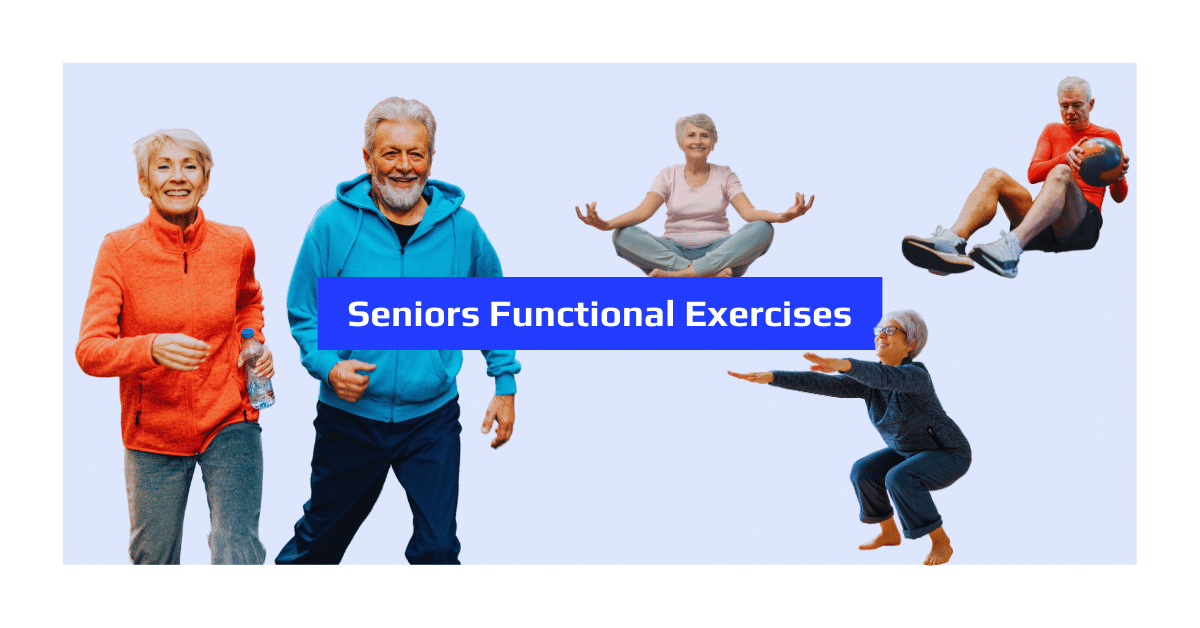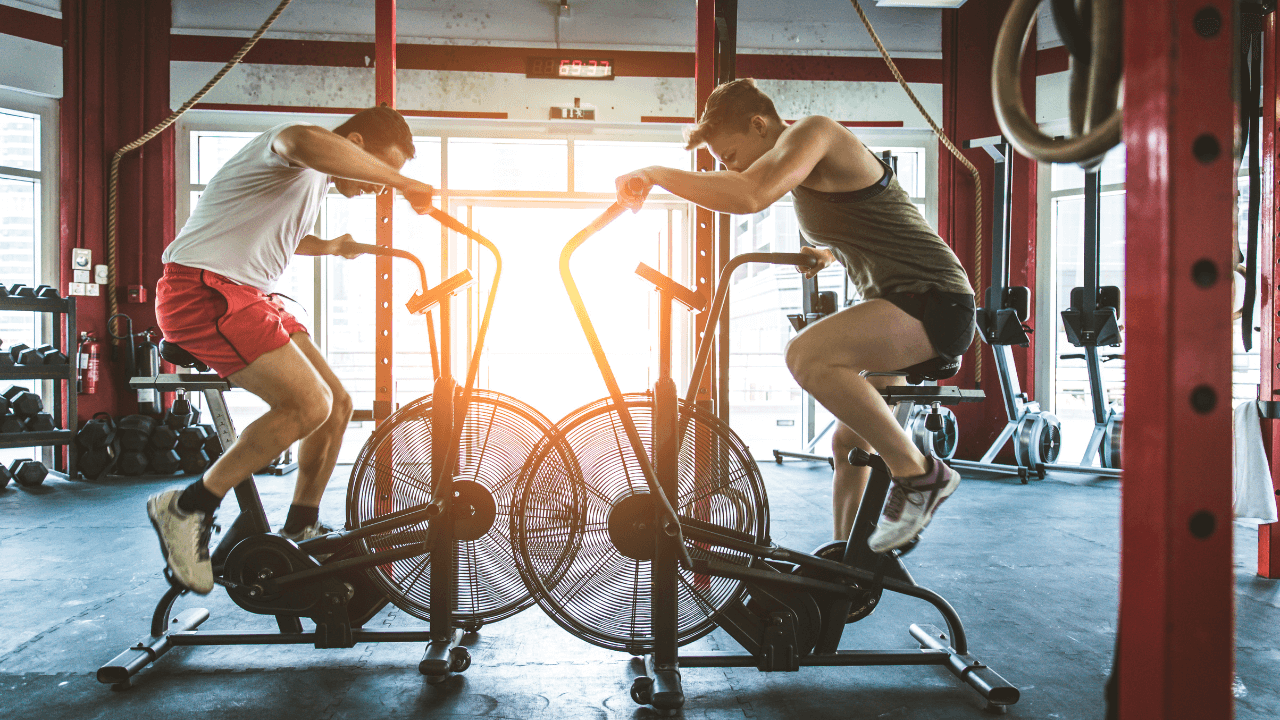Regular exercise during the senior years has been proven to yield numerous positive effects on overall well-being. It helps manage various chronic conditions such as hypertension and type 2 diabetes. Research suggests that muscle strength and endurance can improve one’s quality of life and promote greater independence, underscoring the importance of functional exercises for seniors. Seniors who engage in 150 minutes of physical activity per week have fewer falls and lower rates of chronic conditions. Consistent participation in physical activity has been proven to enhance cognitive function and decrease the likelihood of developing dementia.
Effective Workout Regimen For Seniors
1. Aerobic Activities
Aerobic activity moves all major muscle groups and increases our heart rate and breathing. These are some Aerobic exercises:
- Walking
- Hiking
- Cycling
- Running
- Swimming
We should aim to do at least 150 minutes of moderate aerobic exercise each week. (30 minutes per day, five days per week).
2. Muscle-Strengthening Activities
Muscle strengthening is an activity where we improve muscle mass, strength, or power by doing specific exercises that target our muscles. We should include two weekly workouts targeting all major muscle groups.
Those activities could be exercising with:
- Bodyweight
- Free weights
- Resistance bands
- Other fitness equipment
All of them are suitable for seniors when done safely and at a proper intensity.
3. Balance And Coordination Activities
Balance and coordination are highly recommended for seniors and should be included in everyday life. We can perform them in combination with strength or aerobic activities. An example of such exercises are:
- Standing in a narrow stance
- Single-leg stance
- Tandem walking
We should perform them daily or a few times weekly in short bouts of 10 minutes.
Safety for Seniors
Before beginning your workout with functional exercises for seniors, prioritizing safety is essential to prevent any potential hazards. Ensuring you are dressed in the right attire is the first step. Opt for a comfortable sports outfit, which allows for unencumbered movement and is appropriate for the temperature of your exercise environment. It’s also critical to wear stable sports shoes with securely tied shoelaces to avoid trips and falls.
If your exercise routine is indoors, make sure the space is clear and spacious enough for all movements, significantly reducing the risk of accidentally bumping into furniture or other objects. For those engaging in standing exercises, having a chair close by provides a quick rest spot if needed. Meanwhile, exercises done on the floor should be performed on a mat for added comfort and safety. Remember, incorporating these safety measures will foster a more beneficial and enjoyable experience as you engage in functional exercises for seniors.
You can use a sable chair with or without handles for seated exercises. And always have fun!
Workout Routine For Seniors
We created a workout routine you can perform at home. The equipment you will need is a stable chair. If you are new to exercise, we suggest doing the workouts near a wall for added support. The routine includes 10 exercises for strength. The recommended number of repetitions for each activity is 8-10. If you would like, you can perform them in 2 to 3 sets or start with one.
We included modifications for those who need help with some. You will find seated and standing exercises. If the standing is too difficult, could you perform the seated variation?
The routine starts with 2 warm-up mobility exercises, and then we progress to the main part, with 5 strength exercises. Then, we had two functional movements, including balance and coordination. We finish the workout with a short stretch. Now, let’s start with the workout routine.
1. WARM-UP
1. Seated Swimming
Seated swimming is an effective upper-body mobility exercise that activates all major muscles around your shoulder and upper back. Muscles can become stiff, which affects mobility and decreases our ability to move the arm in a full range of motion.
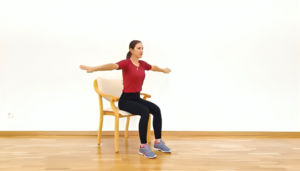
How to perform the exercise
- Take a seat on a sturdy chair with or without armrests.
- Make sure you sit upright, with your shoulder rolled back and your core muscles engaged.
- Position your arms before you and face your palms towards each other.
- Shift your upper body slightly forward while maintaining a relaxed back position.
- Circle with your arms back, turning your palms backward. Imagine performing a swimming stroke.
- Go until your arms touch the backrest on each side. You can sit close to the backrest if you cannot reach so far.
- Travel with your arms on the same path back to the starting position and repeat the movement.
Perform the exercise 8 to 12 times at your own pace. Make sure you go through the full range of motion. As you practice, you will notice your arms can stretch further back.
2. Overhead Raise + Knee Extension
Overhead raises with knee extension. This exercise is an excellent way to work out your entire body, with a focus on both the upper and lower regions. It enhances blood circulation to the active muscles. It is a great way to warm the body or wake up the muscles in the morning.

How to perform the exercise:
- Sit upright on a stable chair with or without support. Keep your knees flexed and arms resting at your sides.
- Raise your arms overhead, moving them up at your sides. When your arms are overhead, bring your palms together if you can.
- At the same time, slide with your right leg forward, extending your knee. Keep your heel on the floor.
- Bring your upper limbs down and bend your right knee.
- Next, raise your upper limbs overhead as the first time, and slide your left lower limb forward, extending your knee. Keep your heel on the floor.
- Repeat the movement, alternating between the left and right sides.
Modification:
If you want to make the exercise more challenging:
- Extend your knee and lift it off the floor.
- Perform the same movement with your upper limbs.
- When you extend the knee, contract your thigh muscles.
Strength Exercises For Seniors You Can Do At Home
3. STRENGTH + BALANCE
1. Sit To Stand
Sit to stand is a daily exercise when standing up from bed or a chair. It is a great way to strengthen the lower body and improve balance. It is an essential functional movement that everyone should practice. We will show you three ways to perform this exercise.
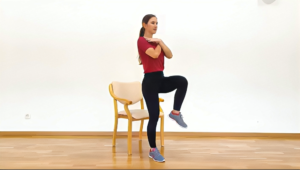
Chair Stand With A Knee Lift
It targets lower limb muscles as well as your coordination and balance. If you are unsure, place another chair in front of you if you lose your balance.
A. Starting with the most advanced version is advised for those with a good balance.
- Sit on the chair in an upright position. Cross your upper limbs across your shoulders, keeping your feet flat on the floor.
- Stand up from the chair without leaning forward and lifting one limb off the ground. Hold this one-leg stand position for 3 seconds. Step down and sit on the chair.
- Repeat the movement and lift the other side.
B. An easier variation and the primary option is to perform the exercise without the leg lift.
- Sit on the chair in an upright position. Cross your upper limbs across your shoulders, keeping your feet flat on the floor.
- Stand up from the chair without leaning forward and sit back on the chair.
- The weight should be on your heels.
C. The third variation is using chair handles
- Sit on the chair with your knees bent and feet flat on the ground.
- Place your upper limbs on each chair handle.
- To rise, position your upper limbs on the grips and rely on them for assistance.
- In the standing position, your upper limbs should be off the handles
- Slowly lower to the chair, place your upper limbs back on the handles, and sit.
- Repeat the exercise.
- Perform 8 to 10 repetitions.
This exercise is a great way to engage your upper body by pushing down and standing up.
Remember, constantly adjust the exercises to your current abilities. Never push yourself too hard. If you need more confidence performing the advanced exercises, start with more manageable ones, and you can progress to more challenging activities over time.
2. NARROW STANCE REACH FORWARD OR WIDER WITH WALL SUPPORT
This exercise combines strength, balance, and coordination. It is a great way to improve hip and ankle stability and balance. We often need to reach forward, and with such exercise, we practice becoming more confident moving around in everyday life and performing daily tasks.
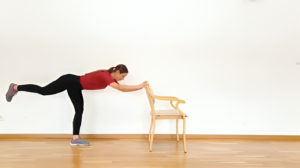
How to perform the exercise:
- Stand facing the back support. Assume a narrow stance with your arms by your sides.
- Step around 1 meter away from the chair. Now, shift forward, hinging at your hips and reaching toward the chair. At the same time, lift one limb off the floor.
- Place your hands on the chair and hold for a movement.
- Return to the starting position and repeat the same, only this time lift the other side.
- As you progress, you can step further away from the chair.
Modification:
If you are not confident enough to perform his exercise without support, you can stand by the wall and place the arm closer. Now, lean forward and slide with your arm on the wall, helping you balance. Return to the starting position and repeat. Alternate between the left and right leg.
Tyr to keep your pelvis in line and hinge at the hips. You want to avoid arching your back. You can bend your knee as much as you feel comfortable. This exercise is challenging, but you will see much progress and improvements in daily life with practice.
4. STRETCH
SEATED HAMSTRING STRETCH
Proper flexibility can help us perform all daily tasks with much more ease, making it particularly beneficial in functional exercises for seniors. Therefore, after every exercise, it is good to perform a quick stretch. The following one will stretch your lower body.
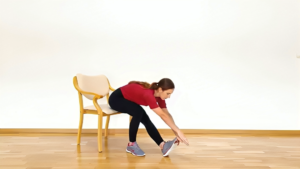
How to perform the exercise:
- Sit on the edge of your chair with your feet planted firmly on the ground.
- Extend your right leg and place your heel down with your toes pointing toward the ceiling.
- Raise your upper limbs before you and place them on each other.
- With your back straight, lean toward the lower limb, reaching as far as possible.
- Hold the position for 15-30 seconds as you get your endpoint.
- Release the stretch and then repeat the same with the other side.
- Straighten your right limb and incline your body, elongating it.
You should feel a stretch in your back leg muscles and lower back. You can perform 2-3 sets on each side.
By incorporating these functional exercises for seniors into your routine, you can significantly improve your ability to perform daily activities with greater ease and confidence while also reducing the risk of injury and enhancing overall mobility and strength. Whether you’re a senior looking to maintain an active lifestyle or a caregiver assisting a loved one, these exercises are essential for promoting independence and overall well-being. Remember to always listen to your body and modify any exercises as needed for your comfort and safety.
Conclusion
An exercise program can help seniors remain independent and prevent falls. This article describes four d that can be part of your daily routine: squats, chair stands, wall slides, and a seated hamstring stretch. Regularly following these functional exercises for seniors will make you stronger, more flexible, and enjoy better mobility. Remember to always get clearance from your healthcare provider before beginning any exercise program.


